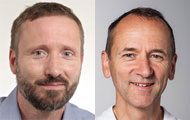OUS scientists partners in project funded by HORIZON 2020 FAST TRACK TO INNOVATION "Intelligent needle tracking using ultrasound imaging for improved minimally invasive interventions" supported by EU

Philips, B.Braun and Oslo University Hospital are partnering in the EU funded INTUI-VIEW project to develop, validate, and bring to the market an intelligent needle tracking technology using ultrasound imaging. The aim of this project is to reliably visualize the needle position in relation to the patient’s anatomy, under ultrasound guidance. The INTUI-VIEW project has been granted €2.36 million.
The participants representing OUH in the project are Axel R. Sauter and Leiv-Arne Rosseland (photo) from the Division of Emergencies and Critical Care at Oslo University Hospital. OUH will receive € 75000 for use in this project, which will be running approximately for 3 years.
Developments in medical care are driven by the need to increase the quality of patient care while reducing cost.
In the field of anaesthesiology, the use of regional anaesthesia, including peripheral nerve block procedures, has led to improved patient outcome and reduced costs when compared to general anaesthesia.
Currently, only a limited number of anaesthesiologists perform peripheral nerve block procedures on a regular basis due to its complexity. Physicians are hampered by the fact that the needle tip location cannot be precisely determined in relation to the patient’s anatomy during a peripheral nerve block procedure. As a result, nowadays anaesthesiologists are largely navigating “in the blind”, using indirect measures and their anatomical knowledge to decide how to navigate and where they should make an injection. Adequate technology would facilitate this procedure and enable a wider adoption of regional anaesthesia.
The solution developed in the INTUI-VIEW project can help to speed up transition from general anaesthesia to regional anaesthesia.
This should result in:
- Patients receiving better, first time right regional anaesthesia procedures; avoiding the risks and potential complications associated with needle misplacements.
- Clinicians getting access to a tool that will allow them to do a better, safer, and faster job with a more predictable outcome.
- Hospitals and health care systems being able to increase their effectiveness and efficiency by avoiding the waste of expensive and scarce resources and reducing patient hospital stay.
Links:
HORIZON 2020 FAST TRACK TO INNOVATION - Projects selected for funding in 2015
Information from CORDIS - the Community Research and Development Information Service:
Intelligent needle tracking using ultrasound imaging for improved minimally invasive interventions